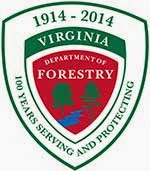Friday, April 23, 2010
Governor McDonnell Announces Conservation of 2,500 Acres of Forestland in Isle of Wight County
Commenting about the partnership, Governor McDonnell noted, “The conservation of these 2500 acres is another step forward towards our goal of conserving 400,000 additional acres of Virginia land by the end of my term. This acquisition was made possible through a partnership by the Department of Forestry, the Virginia Land Conservation Fund and the US Fish and Wildlife Service. It’s this kind of cooperation that will ensure success in our bipartisan efforts to conserve more of Virginia’s environmentally important and sensitive areas. I commend the efforts of all involved, and extend a special thanks to those who have been leading the initiative, in particular Thomas Wright, a member of the Isle of Wight County Board of Supervisors, Paul Burton, interim Isle of Wight county attorney, Mark Popovich, Isle of Wight assistant county attorney, and The Nature Conservancy’s Brian van Eerden.”
Isle of Wight County recently completed the purchase of the 2,507 acres that offer a wide range of public benefits (recreation; forest habitat; protection of old-growth swamp forest; wildlife conservation, and drinking water protection). Isle of Wight County officials, together with The Nature Conservancy (TNC), approached state agencies to secure funding for a permanent conservation easement on the property. The Department of Forestry has secured $850,000 in federal Forest Legacy funds; the Virginia Land Conservation Fund will contribute $566,000; and the US Fish and Wildlife Service will add $75,000 through the North American Wetlands Conservation Act program.
More than 700,000 residents of Norfolk, Virginia Beach and portions of Chesapeake and Portsmouth receive their drinking water from the Blackwater River and other sources. Having a large portion of the adjacent river’s forestland protected through a conservation easement would help ensure clean water for those people as forests function as filters to keep pollutants from entering the river.
Ownership by the County of Isle of Wight should afford new recreational opportunities on more than five miles of the Blackwater, which was recently designated a State Scenic River. By establishing designated launch sites on the property, canoe and kayak enthusiasts will have additional opportunities for some great flat-water paddling. And the network of forest roads offers ample opportunities for walking, hiking, bird watching and other low-impact recreational activities.
The sandy and sandy-loam soils of the upland portions of the land offer ideal conditions for pine management, particularly for longleaf pine, which occurred on the site until the 1970s. This globally rare ecosystem, which stretches from Virginia’s coastal plain to Texas, is considered one of the most ecologically diverse in the world – with more than 900 endemic plant species. It is also one of the most endangered, having been reduced to just 3 percent of its original range. (Longleaf pine was prized for its straight, strong wood – most ships’ masts were longleaf pines – and for its disease and pest resistance.)
State Forester Carl Garrison said, “This forest has so many public benefits, it just has to be conserved. We are very excited to be partnering with Isle of Wight County and our colleagues at DCR to ensure that a significant portion of this property remains a working forest. And we are grateful to The Nature Conservancy, the US Forest Service’s Forest Legacy program and the US Fish and Wildlife Service for their help in this regard.”
Tuesday, April 13, 2010
New Blog Focuses on Recreation
Take a look at http://virginiastateforest.blogspot.com/
Tuesday, April 6, 2010
Western Virginia Faces Very High Threat (Class 4 of 5) of Wildfires Today
Officials with the Virginia Department of Forestry (VDOF) have raised the wildfire threat level to Class 4 (Very High) for the western 1/3 of the state. Conditions (above-average temperatures, low humidity and elevated winds) were already ripe for wildfires during the past four days – and a number of fires burned several hundred acres over the weekend – but with temperatures expected to approach 90 degrees today, the threat level increased from Class 3 High on Monday to Class 4 Very High today.
Under Class 4 conditions, fires start easily from all causes (including cigarettes tossed out car windows) and spread rapidly and with great intensity. Fires that burn in light fuels, such as grass, pine needles, leaves and twigs, may quickly develop high-intensity characteristics, including long-distance spot fires and fire whirlwinds, normally associated with fires in heavier fuels. Outdoor burning of any kind is not recommended during Class 4 conditions. And the state’s 4 p.m. Burning Law remains in effect.
“The threat to life and property is very high,” said Ed Stoots, regional forester for Western Virginia. “We had several large fires over the weekend and the conditions are even worse now.”
Wildfires are dangerous and should be fought only by trained professionals. Call 911 as soon as a fire is beyond your control. The life you save might be your own.
